This is a Voigtländer Brillant, a medium format Pseudo-TLR made by Voigtländer of Germany between the years of 1932 and 1937. This is the original variant with an all metal body and non focusing viewfinder. Although aimed at the low end of the market, it was a well built camera with a unique automatic frame counter and 3-element lens. It represented one of only two attempts by Voigtländer to make a twin lens reflex style camera.
Film Type: 120 Roll Film (twelve 6cm x 6cm exposures per roll)
Lens: 7.5cm f/7.7 Voigtar Anastigmat uncoated 3-elements
Focus: 3 feet to Infinity (unmarked) with indicators for Portrait, Group, and Landscapes
Viewfinder: Scale Focus Brilliant Waist Level Finder
Shutter: Spring Tensioned Metal Blade
Speeds: B, 1/25, and 1/50 seconds
Exposure Meter: None
Battery: None
Flash Mount: None
Manual: http://www.cameramanuals.org/voigtlander_pdf/voigtlander_brilliant.pdf
History
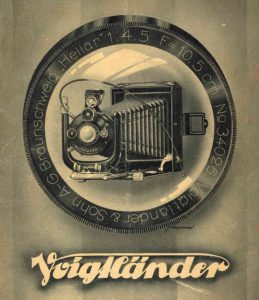
Voigtländer is the world’s oldest optics company, with a history dating back to the 1700s. I spent an unnecessarily large amount of time covering their history in my review for the Vito II so rather than repeat a large amount of that information here, I encourage you to read the first part of the Vito review if you want to know more. For this review, I’ll skip to the beginning of the 20th Century when Voigtländer showed significant interest in building their own cameras, rather than just primarily being a lens maker.
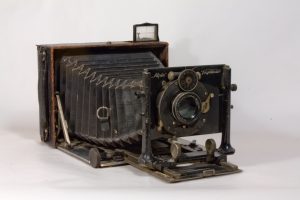
As film photography would gain momentum in the 1900s with models from the Eastman Kodak company and other German makers, Voigtländer started to make a more serious effort into designing their own cameras. In the first two decades of the 20th century, the company would release a wide range of folding plate cameras with names such as Scheren-Camera, Alpin, Stereophotoskop, and Avus.
Voigtländer had great success around this time as both a maker of fine plate cameras and lenses. In 1915, the company would outgrow it’s original factory in Braunschweig and would move to a larger facility on the other side of town. As Voigtländer gained experience making cameras over the next decade, they would experiment with other designs, such as Single Lens Reflex and roll film cameras.
I reviewed an early Voigtländer roll film camera from 1927 called the Rollfilm here, and found it to be a well built, but basic camera capable of really nice shots. Many of Voigtländer’s other roll film designs such as the Avus and Bessa had higher spec shutters and lenses and compared favorably to those made by other German companies like Zeiss-Ikon, Certo, and Nagel.
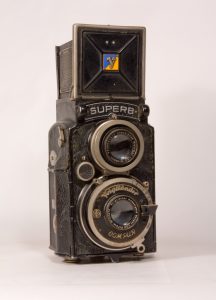
Throughout most of the 1930s, Voigtländer would mainly stick to medium format folding cameras like the Bessa, the Perkeo, and the Inos, but they would also dabble with Twin Lens Reflex and Pseudo-TLR style cameras. In 1932, Voigtländer would release two new models, the Superb and the Brillant. The former was a true TLR design in which the entire lens standard would move in unison with the focus knob. The viewfinder would show a correct representation of the focused image on the viewfinder screen, just like other TLRs of the day such as those made by Franke and Heidecke (Rollei) and other German companies.
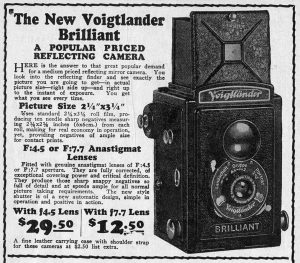
The Brillant on the other hand, was a more basic variant of the Superb TLR with slower lenses and a more basic shutter. It was likely marketed toward novice or entry level photographers. A 1933 Burke & James catalog lists the f/7.7 Brilliant for $12.50 which when adjusted for inflation, is comparable to $237 today. It had more in common with a simple box camera than a true TLR in that the viewfinder’s image is not coupled to the taking lens. The viewfinder is a large and bright “brilliant” image that shows a general representation of the composed image. The photographer is responsible for choosing correct focus and aperture settings from a limited number of options, just like a box camera.
The advantages of both true and pseudo-TLRs is that they offer a “through the lens” experience, similar to a SLR, but without the need for a moving mirror. This simplifies the design and makes for a more reliable and less expensive camera. The TLR format would go on to be a very popular style of camera through the early 1970s with designs by Rollei and Yashica remaining popular for over half a century.
For reasons I’ve never been able to discover, Voigtländer wouldn’t stick with the format for long, with the Superb being discontinued prior to the start of World War II, and the Brillant being reduced to an inexpensive Bakelite model that would continue on until about 1951.
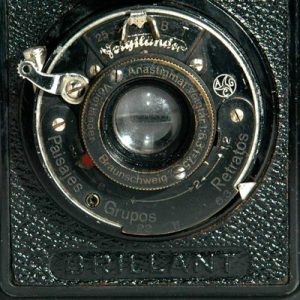
The Brillant seemed to have good success at the beginning, being exported to many countries where it’s name would change depending on where it was sold. In English language countries like the United States and Britain, the camera was renamed the “Brilliant (two Is)” instead of “Brillant (one I)”. When a Brillant was sold in a different market, all of the labels on the controls would be changed to reflect that country’s native language. There exist Voigtländer Brillants in French, Czech, Spanish, Italian, and Polish.
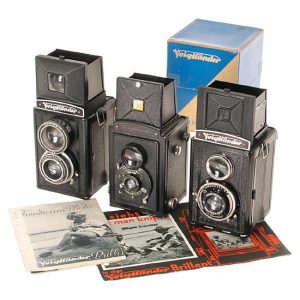
Some higher spec versions of the Brillant were made that had f/4.5 lenses and Compur shutters, but the most common were the f/7.7 version being reviewed here.
The original model was sold with a metal body until 1937 at which time a Bakelite version called the Brillant V6 would debut and remain in production until 1951. The Brillant V6 would grow in size slightly and would also be offered with a focusing version where the taking and viewing lenses are externally coupled, bringing the camera back up to a more traditional TLR design.
Despite these upgrades, the entire Brillant series was discontinued in 1951 and Voigtländer would never again make a TLR or Psuedo TLR. An attempt at a new model was proposed in concept form in 1956 to celebrate Voigtländer’s bicentennial, but none were ever made.
The Voigtländer Brillant, especially the original metal body model, is a rather unique camera with a feature set not found on many other cameras in the marketplace. While the “focus-less” brilliant finder, slow f/7.7 lens, and limited 2 speed shutter suggests a cheap and entry level model, the all metal body, automatic frame counter, and capable 3-element lens suggests an upgrade from the single speed plastic box cameras like the Argus Seventy-Five or Kodak Duaflex, with their meniscus and doublet lenses.

Interestingly, despite the relatively short life of the original Brillant, in 1946 the Soviet company GOMZ produced a nearly identical copy to the Brillant called the Komsomolets (Комсомолец in Cyrillic). The body was very similar to the Brillant V6 and had a non-focusing viewfinder and simple shutter and lens combinations like the original Brillant. Later versions of the Komsomolets would become the Lubitel TLR which had an externally coupled viewfinder, just like the Focusing Brillant. The Lubitel would evolve over the course of the next few decades, being in production until 1996, far outlasting the production run of the model it was based off.
Today, almost anything with the Voigtländer name is highly collectible with models such as the Prominent and Bessas fetching very high prices. Even the “lesser” models like the Vito and Bessamatic series usually demand a slight premium over competing models. The Brillant however, seems to go relatively unnoticed in the collector’s market. Perhaps it’s the relative obscurity of this model, or it’s appearance as “just another cheap” camera that turns people off. Based on my initial reactions with the Brillant, I think that if more collectors would give this model a chance, it’s reputation would grow. Maybe that’s not a good thing since prices are so low, they represent such a huge bargain in the user market!
My Thoughts
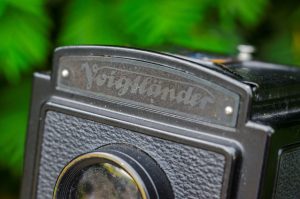
I first stumbled upon a Voigtländer Brillant in September 2015 at a camera sale in Chicago where a collector was liquidating his collection. At that sale, I picked up a Argus A2F, a Detrola Model E, a Kodak Signet 35, and a few other cameras. I remember handling a Brillant and noted that it was an extremely basic camera that appeared to be in very worn condition. As I recall, the guy was only asking $5 for it, and in a moment of dumbfounded idiocy, I passed on the chance to take it home.
That decision would haunt me over the next year or so as I came to learn more about this model. Sure, it has a limited selection of shutter speeds and aperture sizes, and yeah, it’s a Pseudo-TLR that won’t show you an accurate representation of your composed image. But what is unique about the Brillant is for what it did do, it did extremely well.
I finally located another example in a lot of other cameras which when averaged out between everything else it came with, only cost me about $15. The camera was in excellent condition, but like most Brillants I’ve seen most of the original artwork including the “Voigtländer” logo and the printing around the lens has faded away. I assume some type of paint was used when these cameras were new, which over the course of 80+ years simply fades or rubs off. I actually like the look though, as it gives the Brillant a unique patina that you don’t often see with other cameras.
Handling the camera is a joy. Although I keep using the term “Pseudo-TLR”, its worth mentioning that this is much smaller than most TLRs. The Brillant is very compact and fits comfortably in the palm of your hand. The entire camera weighs only 502 grams, yet still feels solid in a way that inspires confidence, unlike many cheap plastic cameras of the day. Although mine has the basic spring loaded metal blade shutter with only two speeds, this camera could optionally be equipped with a Compur shutter. Even with the basic f/7.7 lens, it is still brighter than the many f/11 and smaller lenses found on basic box cameras of the day. The signature feature of course is the large “brilliant” viewfinder on top of the camera.
This style of brilliant finder is where a Pseudo-TLR like this differs from a regular TLR. On a regular TLR, both lenses are coupled and move together as the focus of the taking lens is changed. This allows the photographer to see an accurate representation of the final image through the viewfinder including which elements will be in or out of focus. The downside to this method is that in order to see things in focus, you need to look through a focusing lens with an opening usually around the same size as the taking lens. The best TLRs have viewing lenses with an f-stop of f/2.8, but most are f/3.5 and smaller. This darkens the image in the viewfinder, making it more difficult to see the composed image in low light.
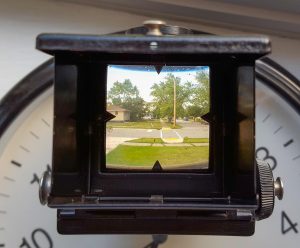
In a Pseudo-TLR, the viewing lens is usually a simple single element lens that lets the majority of the light through, allowing for a viewfinder that is large and bright. In the image to the left, the viewfinder shows an image that is nearly as bright and vivid as the scene the camera is pointing at.
The downside to this however, is the loss of focus ability in the viewfinder. Pseudo-TLRs work much like box cameras in that the viewfinder shows everything in focus all the time, no matter the distance. In order to properly set focus on the taking lens, the photographer must either manually measure the proper distance from the camera to the subject, or use one of many zone focus methods employed on the millions of viewfinder only cameras that have been made throughout the 20th century.
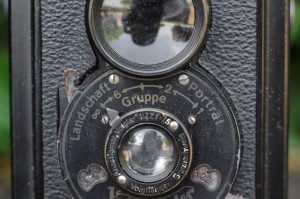
This is where the slow maximum aperture of f/7.7 comes in handy. At that size, the camera already has a very large depth of field, meaning that as long as your subject is within a specified zone, it will be in focus. The Voigtländer Brillant has a lens that theoretically can be focused to any distance over 3 feet, but there are no distance markings on the lens. Instead, are 3 indicators for Portrait, Group, and Landscape. Since the Brillant was exported to a variety of countries and the text was available in a variety of languages, mine being in German, it says Porträt, Gruppe, and Landschaft.
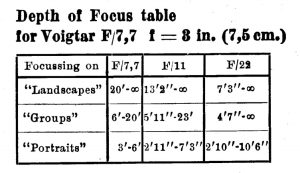
The owner’s manual for the Brillant does not state exactly what the actual distance settings are for Portrait, Group, or Landscape, but it does offer a depth of field table that explains what will be in focus at each of these settings. The table on the left comes straight out of the manual and shows how much latitude you have with your focus estimations. At the Brillant’s “wide open” setting, when set to Group, everything from 6′ to 20′ is in focus. The Landscapes setting offers a max focal distance of infinity at all three f-stops.
It’s this use of zone focus that makes the Brillant such an easy camera to shoot. I would argue that it’s easier to use than most TLRs since the view through the viewfinder is so large and bright, and as long as you don’t attempt closeups, it’s very hard to not get something in focus. This aspect of the Brillant appealed to me and allowed me to really enjoy shooting with it.
The uniqueness doesn’t stop with the lens. To the best of my knowledge, the Voigtländer Brillant is the only “Pseudo-TLR” with a built in exposure counter. On the photographer’s right side of the camera is a oval shaped red window with a frame counter allowing you to advance the film without having to use the exposure numbers on your film’s backing paper. It doesn’t automatically stop at each new exposure and it doesn’t offer double image prevention, so you must still pay attention to it, but this is a pretty cool feature that was absent on many medium range TLR’s like the Reflekta II, Ciro-Flex, and the Yashica A.
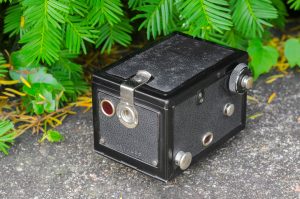
Loading the film is mostly familiar to anyone whose used a TLR before, with just a hint of uniqueness. Unlike most TLRs, the film compartment has two separate doors, one on the back and one on the bottom. The bottom of the camera is held in place by a metal latch that must be lifted upward in order to swing open the bottom. Once the bottom of the camera is open, the back swings up.
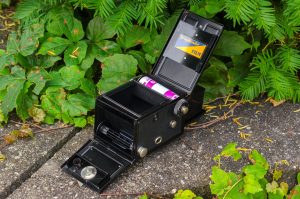
The supply side of the camera is on the bottom where a fresh roll of film must be installed. On the outside of the camera are two nickel metal knobs that must be pulled out to insert a new spool. When threading the backing paper toward the takeup spool, you MUST thread the paper under the felt lined piece of metal near the corner. If you do not do this, when you close the camera, you will cinch the paper and it will not feed correctly.
The takeup spool is near the top of the camera. In the image to the left, I have a fully exposed roll of film in the takeup side. Loading in an empty spool is just like loading in a new roll of film, There are two nickel metal knobs (one of which is in the middle of the film advance knob) that must be pulled out so you can slide the spool into position. Once both spools are in position and the film is correctly threaded into the takeup spool, turn the film advance knob in the direction of the arrow a few turns to make sure the film is wound securely to the takeup spool. Once you are sure it is secure, close the camera back up opposite of how you opened it.
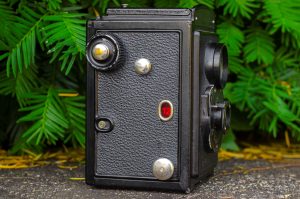
With a fresh roll of film installed inside of the camera, you need to advance the film to the first frame using the red window on the bottom of the camera. Some Brillants have this red window on the back instead of the bottom, but the process is the same regardless of it’s location. Keep winding the film until you see the number 1 through this red window. The Brillant will not automatically stop at the first exposure, so you must pay close attention. I found this window to be quite dark on mine so I had to pay close attention while winding it. Once you see the number ‘1’ in the red window, you must reset the automatic frame counter by sliding the metal tab on the side of the camera, to the left of the red frame counter.
Once both red windows on the bottom and side of the camera are at exposure number 1, you are ready to shoot the camera. The larger, and much easier to see, frame counter on the side of the camera can be used for the remaining 11 exposures. Again, the camera will not automatically stop after each new exposure, so you must pay attention to the numbers as you advance the film. Like most medium format cameras, if you go past a frame number, there is no way to rewind the film backwards without opening the camera in a dark room and doing it by hand.
The Voigtländer Brillant being reviewed here was the entry level model. There were other variants with a better f/4.5 lens, more advanced Compur Shutters, and even a model called the Focusing Brillant which used an external coupling between the taking and viewing lens to allow the photographer to see focus in the viewfinder, but each of these upgrades has a negative effect on the best parts of the camera. The faster f/4.5 lens might be capable of sharper images and would certainly be more useful in lower light situations, but wide open it would reduce the wide depth of field area that the f/7.7 lens allows for. The Focusing Brilliant would negate the large and bright brilliant viewfinder, resulting in a dimmer image, making it harder to use in low light. Finally, the Compur shutter would have unnecessarily increased the cost of the camera possibly putting it out of reach of the first time photographer who might have been in the market for one.
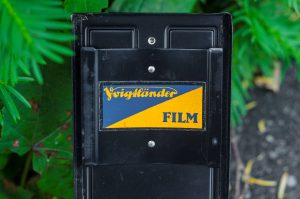
It’s these reasons that I think the best variant is the basic one. I don’t know of any other camera where the basic model is more appealing than the more well equipped models. To be fair though, I haven’t ever used one of the higher spec Brillants, so perhaps there’s something else about them that make them just as great.
Before taking the camera out for it’s inaugural roll, I played with all of the settings to make sure the camera was in good working order and it was. This camera predates the use of foam light seals, so there was nothing in the way that I could see which needed replacement. I loaded in a roll of a decade expired Kodak Portra 160VC thinking that it would make a good pairing with the Brillant’s 1/50 maximum top speed. Portra loves to be overexposed, plus being 10 years expired, it should be a perfect match.
My Results
The speed at which I get through a roll of film is usually consistent with my opinion of a camera. The more I like the camera, the faster I get through the roll. I shot all 12 exposures on the roll in a little over a day which was definitely a good sign. But how would the pictures come out? Even though I was confident that the camera was in good working order, this thing is 85 years old and there is any number of ways in which it could fail.
I was able to finish this roll just days before sending off a batch of film to Neil at Willow Springs Photo Lab, so I didn’t have to wait long to see the results…
This roll was developed in a batch of film shot in Nikon SLRs and other very capable cameras that I expected great things from. The Brillant was one of the bigger question marks due to it’s age, design, and simplicity, but when I saw these images, I was very impressed. They weren’t perfect, but overall, I was very pleased with what I got.
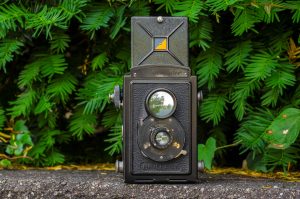
All doubt that this is a cheap camera with a low quality lens should be gone after seeing these images. Center sharpness is excellent. If you zoom in the image of the flowers in your browser and look at the center, the level of detail is incredible. There is some softness near the corners, but otherwise I’d rate the Voigtar’s performance as on par with other triplets of the era. I did notice some slightly strange color casts to some of the images which is likely due to the expired Portra, but could also be caused by the uncoated lens, but I didn’t think it looked bad. If anything, it added to the “vintage” look that you might expect from an 85 year old camera.
Not only did I love shooting with the Brillant, but the images I got back from it reinforce my enthusiasm for this model. The Voigtländer Brillant is a great camera that is fun to use, makes good images, and checks all of the right boxes in my mind for what I like about shooting with vintage cameras. I love the way this camera looks, I enjoyed shooting with it, and the limited control of aperture and shutter speeds did not impede me at all.
It should be pretty obvious by now that I love this thing and absolutely recommend one to anyone looking for a fun and easy to use old camera. These show up for sale on eBay quite often, so the next time you see one for a decent price, I absolutely recommend picking one up!
My Final WordHow these ratings work |
The Voigtländer Brillant is one of the most unique cameras in my collection. It’s neither a TLR, or a box camera. It has a modest feature set, but is not a cheap camera. The camera is very compact, portable, and a lot of fun to shoot. The three element f/7.7 Voigtar lens is capable of really nice images with excellent center sharpness and a pleasing softness around the edges. The small aperture affords a wide depth of field making focus estimation a snap. Added together, the well built body, the excellent controls, and ease of use make for a very enjoyable camera. I thoroughly enjoyed my first roll through this camera and cannot wait to use it again. Highly Recommended! | ||||||
| Images | Handling | Features | Viewfinder | Feel & Beauty | History | Age | |
| 1 | 2 | 1 | 1 | 2 | 0 | 40% | |
| Bonus | +1 for overall excellent, the complete package | ||||||
| Final Score | 10.8 | ||||||
Additional Resources
http://camera-wiki.org/wiki/Brillant
http://camerapedia.wikia.com/wiki/Voigtl%C3%A4nder_Brillant
https://yanivberman.com/2012/03/02/voigtlander-brillant/
http://voigtlander.pagesperso-orange.fr/anglais/brillanttousA.htm
http://www.cinci.de/brill.html
http://www.collection-appareils.fr/x/html/page_standard.php?id_appareil=11776

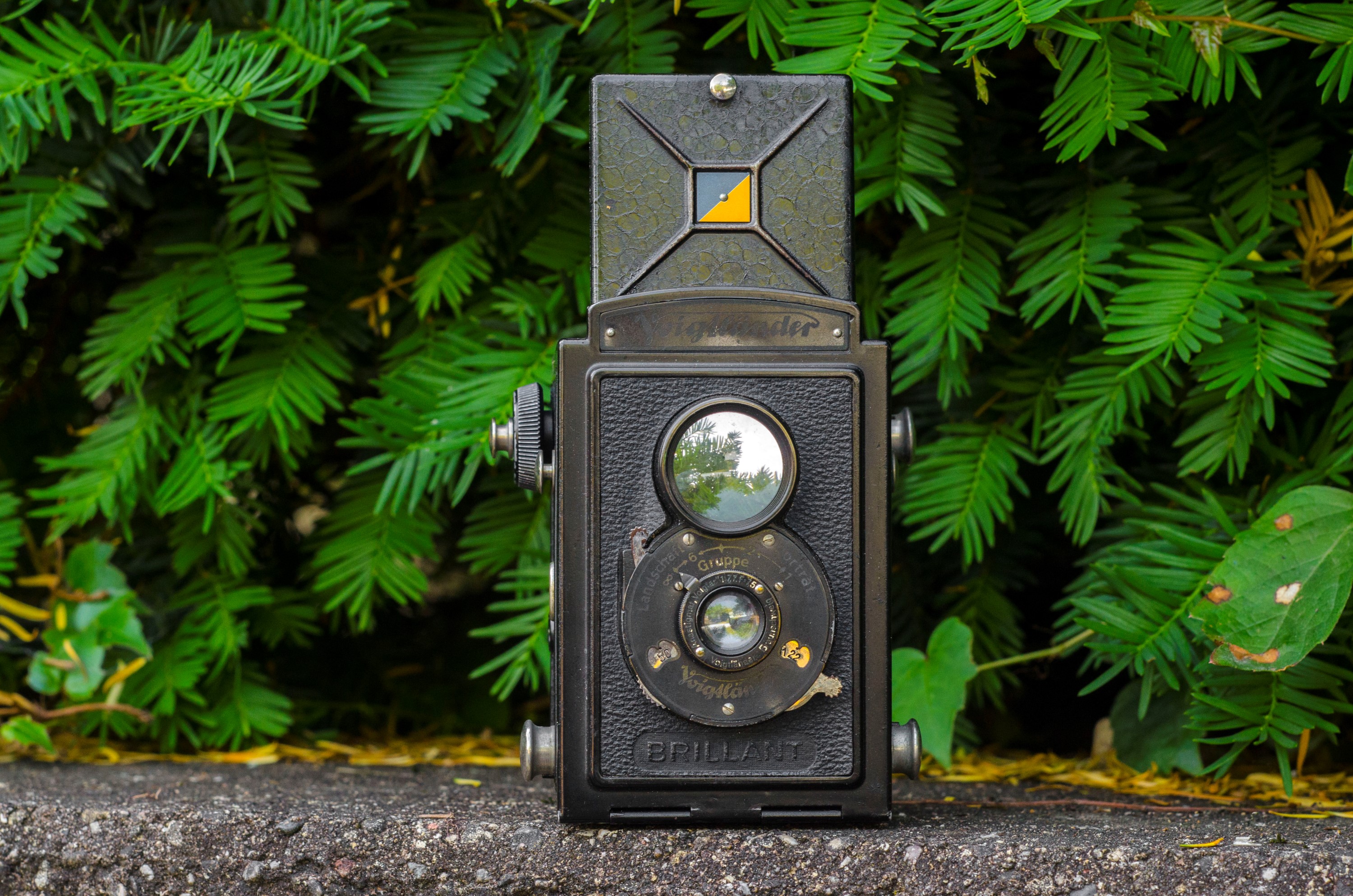

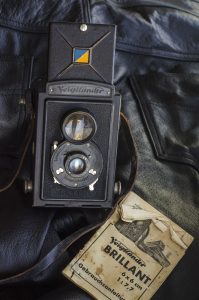








How wonderful. I love your reviews. You got some mighty nice pictures out of that old camera.
Phenomenal results I would say. To me these look even better than my favorite “Box TLR,” the Argus 40, and the uncoated lens leaves a very nice color palette on the Portra! I’m hard pressed to “need” one of these to get one for myself, though I guess I can say that about nearly everything I have.
I have the exact camera and finished my roll yesterday. Can’t wait to see the very first results!
A decent metal version with similar eroded lettering around the lens belonged To my granddad. We found it after he died. It might be The camera used to take propaganda photos to send home when he was forced labourer in nazi Germany. Ofcourse they are b&w.
Totally agree its a nice contraption, after all these years the four blades of the viewfinder snap into position like the spring is new.
I found a 1935 Brillant and love using it – for something so ‘primitive’, it really takes good photos. Enjoyed your review very much: it sums up my own experience with thre camera.
I’m glad you liked the review Ian! I just recently reviewed the Argus Argoflex Forty which is a very similar camera to this Brillant. I recommend checking out that review!
I have just begun to enjoy these old cameras. I have a focusing one with a Skopar lens, and it is hard for me to believe the wonderful quality of photographs it produces. I use only b&w film. Thanks so much for your article!